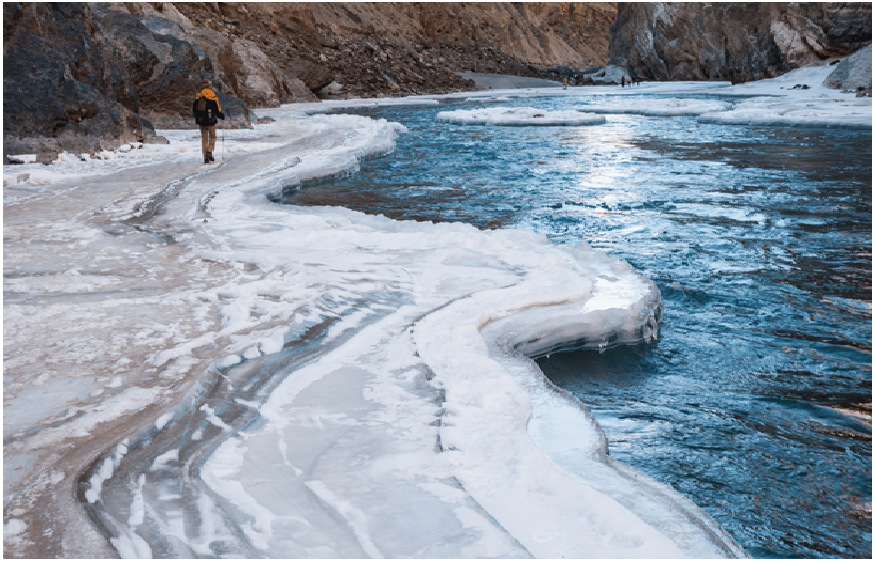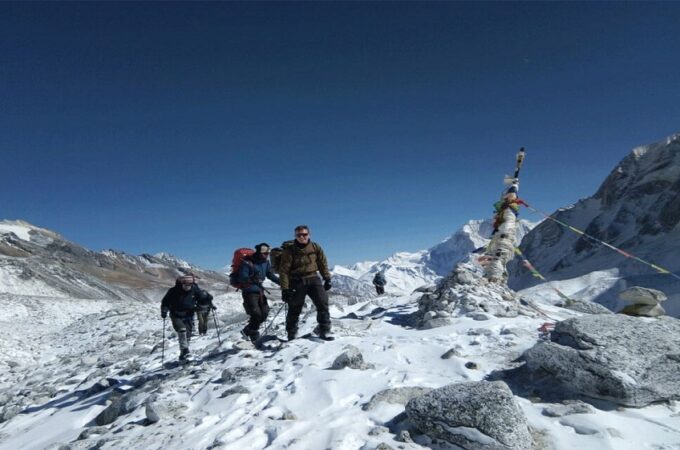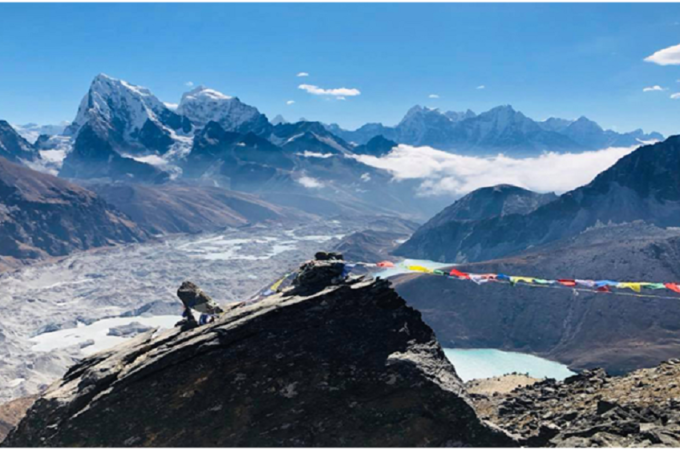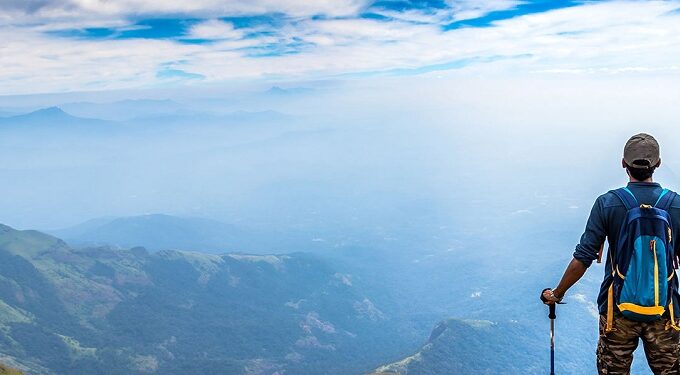
Chadar trek in Ladakh – The famous frozen river trek of India
The Chadar trek is an ice-cold winter trek on the Frozen Zanskar River within the Indian union territory of Ladakh. This trek is one of the most challenging and exciting trekking routes in India. It involves much trekking up the slippery surface of the frozen river. One has to cross many bridges on the way and make many changes of direction.
Reputed tour operators for the Chadar trek
A skilled guide is very important to pursue a Chadar trek. Ladakh-tourism is known for the Chadar trek in Ladakh. They have experts with skilled guides and good knowledge of the area which is required to complete the trek.
History of Chadar trek
It is historically the only feasible way of traveling in this region during the icy winter months. The isolated locals of Zanskar valley use this frozen river trail to get to other places of Ladakh. There are two main ways to reach the end of this route – the Ladakh Way and the Zanskar Way. Both take around 4 days to complete.
Trekker from around the world
The trail has gained popularity among outdoor enthusiasts from all over the world. It offers a great trekking experience through a more beautiful and diverse land than any other place in the world. It is sporadic to come across such a captivating landscape in such a cold region.
For those interested in adventurous and challenging trekking, the Chadar trek is for those. Here, one has an opportunity to view the natural beauty of the valley. One can also view the fantastic view of the lofty Zanskar range on the way to Ladakh. On reaching the valley, one has an opportunity to see some of the stunning high peaked mountain peaks of the world.
Although Ladakh is one of India’s highest and most challenging trekking destinations, it has less crowded trekking trails. Hence, adventure seekers from all over the world can easily pursue their goals. Ladakh is also known for its majestic mountains. The mountains of Ladakh make the region a perfect trekking destination for nature lovers.
Best time for the Chadar trek in Ladakh
The ideal season for the Chadar trek in Ladakh is between January & February. Snowfall from December makes the trail frozen for trekking in Ladakh. As there are no vehicle roads, the only way to travel to the Zanskar valley is by foot. Hence, trekking here is an excellent option to explore the region’s beautiful valleys during these months.
Chadar trek route
This trekking route starts from the town of Chadar and covers the Zanskar River. The route follows the frozen Zanskar River trail from Chilling and passes through the Zanskar Valley. The path then curves slightly upwards and leads to the Nerak village. Here, there is an excellent view of the fabulous waterfall. The final trek ends at a picturesque location of Nerak Village.
It is straightforward to follow the Ladakh trekking trail and the Zanskar trek on an indirect road. The frozen river can be safely crossed by strolling on the ice. This road also takes one through a famous Cave known as Tibb cave. This trek is also top-rated among trekkers since the route offers a spectacular view of the gorgeous valleys, snow-capped mountains, and stunning landscapes of the region.
Most of the trekkers stop their journey at Nerak Village, where they arrive through the frozen Zanskar river to the enchanting valleys. They then make their way back to the Tibb cave on the river’s frozen passageways. The trek covers the frozen trail of the mighty Zanskar river, which have three streams flowing into it.
However, be cautious as there are many trekking routes in Ladakh that are not environmentally friendly and may endanger the region’s precious natural resources. Therefore, before embarking on any trekking trip in Ladakh, make sure that it does not involve trekking through areas suffering from severe environmental degradation. Seek guidance from Ladakh-tourism before embarking on the trekking. Moreover, local people also help build an eco-tourism infrastructure in and around Ladakh to support environmental preservation.
Acclimatizing for the Chadar trek:
Acclimatization to the Zanskar trek can be achieved in two ways. One is to work with a high altitude trekking tour operator Ladakh-tourism, who will guide in the acclimatization process and help the trekking enthusiasts reach the Zanskar base camp. Once at the base camp, the trekkers will go through a proper acclimatization program. However, it should be noted that proper acclimatization is a two-stage process, requiring at least three days.
The first step in acclimatization is being adapted to cold temperatures. The trekker must be sure, however, that they have sufficient clothing and supplies for the trip. They will need special clothing made of wool, for example, as it allows the skin to breathe. Other supplies, such as liquid food and emergency food, should be carried on a regular basis. Also, one should have a good sleeping bag, a warm towel, thick socks, thick gloves, and a face mask. It is also essential to carry a stove and cooking equipment and tents.
The second step in acclimatization, which happens at higher altitudes, is increasing the body’s energy. The climber must acclimatize gradually. There are different methods for this, known as steady-state and not too different from the general acclimatization process. Essentially, this means following a rigorous diet and doing much physical work on the trek to keep the body warm. However, the trekker is expected to keep the food intake small so that the body has more energy to expend on the trekking.
Mountaineering equipment can also help with acclimatization. In some high mountain ranges, the climber should carry high-quality ductless coolers, sleeping bags, extra clothing, ropes, and other items that will allow the person to remain as warm as possible. On the other hand, in some other high places, where the climate is sub-tropical, acclimatization can come down to carrying more clothes, eating more often, and taking more rest. In either case, acclimatization does not mean one will never get cold; it just means that one need to adapt to the cold and try to stay warm.
Acclimatization for a Chadar trek can take a couple of days or more, depending on the trek’s altitude and difficulty. Most people begin acclimatization at the base camp Leh and then at higher campsites, where they live off generators and other steady food and drink sources. The high altitude trekkers tend to have tents and sleeping bags, but even this acclimatization can be problematic for some, especially those who plan to trek for the first time and who are still making adjustments to their diets and sleep cycles. For the experienced high altitude trekker, acclimatization can take a couple of days, during which time they can sleep well every night and eat small meals on the trek, rather than having to improvise for few days.
Chadar trek itinerary
Day 1: Fly to Leh
You will land at Leh Airport, which is one of the higest airports you will ever encounter. It is crucial to stay warm because once you arrive at Leh Airport, the temperature will drop suddenly. All winter clothes including Jackets, wool gloves, and wool hats, are essential. After arriving at the Leh hotel, you will have rest to acclimatise and adjust to various weather conditions. In the evening, you can spend some time shopping at Leh Market. It is vital to adapt to the cold temperature of Leh because the temperature keep decreasing during your trekking towards Zanskar valley on the icy river. It is also important to keep the body hydrated by increasing water intake, which will help maintain body temperature.
Day 2: Leh Sightseeing and Acclimatizing
- According to the current new regulations, you have to stay in the base camp for atleast three days; please keep in mind other hikers’ health issues (AMS). So, you have to stay in Leh for at least two days to allow your body to fully adapt to the weather conditions.
- You can spend the day visiting various places in the town. It is recommended to avoid visiting higher altitudes.
- You will spend the night at base camp Leh.
Day 3: The day of Health Check
- Today you will visit the medical camp at the announced time. Get to the medical at least 15 minutes before the time to avoid last minute rush. Although the test took less time, it was delayed due to the rush of tourists.
- After the checkup, you can enroll in travel insurance for the CHadar trek.
- If the checkup announces that you are not suitable, proceed for refund policies.
Day 4: Leh to ShingraKuma, then to Gyalpo
- First day of trekking
- Start with sightseeing on the roadway to ShingraKuma.
- On this day, you will trek to the first camp, Gyalpo, via Chilling and ShingraKoma.
- The taxi will take you to the end road, and then you walk up to the point of Chadar trek’s point.
- ShingraKoma is a unique place in Chadar because it is located at a U Bend of Zanskar river. The scene of the flowing river on both sides is epic. A magical sight with a chilly night.
- Today, it will be one of the most scenic drives, allowing you to see some of the best sights in Ladakh.
- You will spend the night at Galpo camp. Stay warm.
Day 5: From Tsumu in Dar to Tepe Cave
- After spending the first cold night in a tent of Gyalpo, you will feet good in the moring.
- Continue the Chadar trek after eating breakfast.
- In such cold conditions, a much-needed cup of hot tea will be memorable.
- As you begin your journey to the next campsite, Tibb Cave, this itinerary will include some of the most dramatic frozen waterfalls you have ever seen.
- The mighty Zanskar will come all the way on the trekking, and it will take you to the Tibb cave.
- Have your lunch halfway to Tibb cave.
- After walking for a few hours, when the sun shines on the rocks, you will encounter different rock patterns that look very artistic.
- You will reach Tibb cave in 6 hours.
- Spend the night at the Tibb cave
- Tibb cave is in the middle of sand and small pebbles that look wonderful.
Day 6: Nirak village and waterfall
- Start the trekking after breakfast
- Today you will get the chance to see the most famous waterfall of Ladakh.
- Lunch in midway to Nerak
- Visit the village of Nerak after visiting the waterfall.
- Tonight would be the coldest night of your whole trekking, where temperature may decrease up to -30°C.
Day 7: Back to Tibb
- After breakfast, head back towards Tibb cave.
- Have your lunch in the midway to Tibb.
- Tonight is the last night of your camping. Have fun.
Day 8: Back to the base camp Leh
- Today is the last day of your trek on the frozen trail of Zanskar river.
- Today you have to trek the longest trail of the Chadar trek.
- Reach ShingraKuma and the taxi will pick you up.
- Head back to Leh driving.
The frozen layer of ice may look very thin, and you can see many rock formations on the first day of the trek. Stay with the group and the guide. In the first stage, walking in boots is a challenge. Expertising the walking pattern on the ice will take some time, but you will know which surface is fragile and which surface is trustworthy with each step. When walking the mighty Zanskar, you may encounter many types of ice, and when you start walking, you will learn more about them. Implanting the foot correctly is important, and you can check the snow’s stability with a stick before stepping on it. This lightweight backpack will help you manage your weight effectively.
Important advice for Chadar trek
- It would be best if you had the guidance and expertise of locals in the Chadar trek. Ladakh-tourism.net is a locally known operator of Chadar trek. They are the best in the game and very reliable as per recommendations of other trekkers.
- Whatever you do, don’t trek solo on Chadar trek. It can be very dangerous.
- And stay with the groupand follow the guide’s instruction properly.



